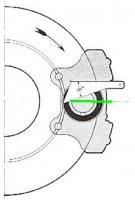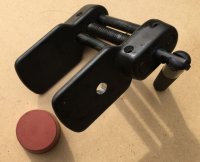PMB_Performance
Member
- Messages
- 20
- Reaction score
- 1
Piston Removal
If you were unable to move the pistons in the previous steps and you want to carry on, hang in there. Here’s where we’ll explain some drastic bench top measures to get them free. Again, your calipers will fall into two categories; 1) pistons that are moving freely and 2) pistons that are going to give you trouble. Let’s get the easy stuff out of the way first.
I like to remove the inside piston first. This is the piston that is in the ½ with the mounting ears. Put a c-clamp on the outboard piston to hold it in place, make sure your bleeder valve is secure and pad the bore with a shop towel. Using compressed air, insert the nozzle in the fluid inlet and gradually squeeze until you see the piston start to move out of the bore. Try to feather it out and by all means KEEP YOUR FINGERS AWAY FROM THE BORE. When these pistons come out using compressed air they can be traveling at bullet velocity. This is why you pad the bore. You can very easily damage the piston tops and the opposing bore this way. In fact, if you "can" use fluid, I recommend it over any method.

Once the inboard piston is out you can put a larger rubber stopper in the bore and cap it off with a steel plate. I like to use a long steel plate that extends into the jaws of the vise so the vise can hold the bottom portion while the top is held in with your c-clamps. An alternative is to use the old brake pad backing plate and strategically place your c-clamps so the plate will hold the stopper in. This is more critical on pistons that are stuck vs. free moving pistons. Using the compressed air and padding the cavity again, pop the other piston out of the bore. Rinse and repeat for your remaining calipers. Count your blessings that you had pistons that were fairly free in their bores. Don’t worry about bore positions and which pistons came out of which caliper, it will al be self-explanatory upon re-assembly.
Stuck Piston Removal
If you were able to get your pistons to move while they were still on the car, we’re headed in the right direction. At this point, try the compressed air method described in the paragraph above. You “might” get lucky but, I wouldn’t plan on it. The only way to get these stubborn pistons out is with fluid. As mentioned earlier and in your Jr. High physics class… fluids don’t compress so they will blow out just about any stuck piston. The problems will be a ) getting the fluids into the caliper and b ) maintaining pressure on the caliper once you get one of the pistons out.
Let’s start with getting fluid into the caliper. Water is a fluid and that’s what we use at the shop. Cleanup is a snap but configuring a water pump can be troublesome. If you’ve searched the internet boards a popular procedure is an air powered grease gun. It is an attractive option because most of them have a 10x1 fitting hiding underneath the zerk tip or… you can easily get a zerk adapter with a 10x1 male end that will screw right into your caliper fluid inlet. The only problem is… clean up. Clamp off the outer pistons and start pumping the fluid of choice into your caliper. The nice thing you’ll notice with this method is the pistons will come out in a very slow controlled fashion. There’s no need to pad the bore.
Here's a shot of the rear piston after it plopped out with water. You cal also see here why I confess my love for painted calipers almost daily (yes, I'm a smart@$$ sometimes... well, most of the time):

If they’re “still” not moving, here are a few tips. Some say heat, I’ve never seen a tremendous return on this investment but, it really can’t hurt at this point. You can get out the MAPP torch and heat up the caliper casting to possibly expand the metals and help break a bond. The “best” method I’ve found is to move the piston inward using a large c-clamp. The point isn’t which direction you move the piston; it’s that you need to break the bond. By applying pressure on the piston top and moving the piston in you should be able to break that bond and get it out. Using a large c-clamp, screw it in until you hear the “snap”, at this point you should be good to go.
A final note on stubborn pistons; watch for the pistons “c-o-c-king” in the bore as they come out. With these stuck pistons, a lot of times they will want to bind on one side or another causing it to c-o-c-k in he bore. Take a large screwdriver from the low side, place it in the dust boot groove and correct the angle (you should feel a little snap as it goes back into alignment) and keep pumping. Do not attempt to pry the piston out with the screwdriver. Just position it against the wall of the pad cavity and use it more as a pry bar to position the piston properly in the bore.
As mentioned earlier, getting the second piston out can be troublesome. Often, with these stubborn pistons, the pressure needed to get the out will be immense (remember the cracked flange picture in the previous post). Your success will be determined by how well you can use the stoppers and the metal plates to keep that pressure contained in the caliper body.
If you were unable to move the pistons in the previous steps and you want to carry on, hang in there. Here’s where we’ll explain some drastic bench top measures to get them free. Again, your calipers will fall into two categories; 1) pistons that are moving freely and 2) pistons that are going to give you trouble. Let’s get the easy stuff out of the way first.
I like to remove the inside piston first. This is the piston that is in the ½ with the mounting ears. Put a c-clamp on the outboard piston to hold it in place, make sure your bleeder valve is secure and pad the bore with a shop towel. Using compressed air, insert the nozzle in the fluid inlet and gradually squeeze until you see the piston start to move out of the bore. Try to feather it out and by all means KEEP YOUR FINGERS AWAY FROM THE BORE. When these pistons come out using compressed air they can be traveling at bullet velocity. This is why you pad the bore. You can very easily damage the piston tops and the opposing bore this way. In fact, if you "can" use fluid, I recommend it over any method.

Once the inboard piston is out you can put a larger rubber stopper in the bore and cap it off with a steel plate. I like to use a long steel plate that extends into the jaws of the vise so the vise can hold the bottom portion while the top is held in with your c-clamps. An alternative is to use the old brake pad backing plate and strategically place your c-clamps so the plate will hold the stopper in. This is more critical on pistons that are stuck vs. free moving pistons. Using the compressed air and padding the cavity again, pop the other piston out of the bore. Rinse and repeat for your remaining calipers. Count your blessings that you had pistons that were fairly free in their bores. Don’t worry about bore positions and which pistons came out of which caliper, it will al be self-explanatory upon re-assembly.
Stuck Piston Removal
If you were able to get your pistons to move while they were still on the car, we’re headed in the right direction. At this point, try the compressed air method described in the paragraph above. You “might” get lucky but, I wouldn’t plan on it. The only way to get these stubborn pistons out is with fluid. As mentioned earlier and in your Jr. High physics class… fluids don’t compress so they will blow out just about any stuck piston. The problems will be a ) getting the fluids into the caliper and b ) maintaining pressure on the caliper once you get one of the pistons out.
Let’s start with getting fluid into the caliper. Water is a fluid and that’s what we use at the shop. Cleanup is a snap but configuring a water pump can be troublesome. If you’ve searched the internet boards a popular procedure is an air powered grease gun. It is an attractive option because most of them have a 10x1 fitting hiding underneath the zerk tip or… you can easily get a zerk adapter with a 10x1 male end that will screw right into your caliper fluid inlet. The only problem is… clean up. Clamp off the outer pistons and start pumping the fluid of choice into your caliper. The nice thing you’ll notice with this method is the pistons will come out in a very slow controlled fashion. There’s no need to pad the bore.
Here's a shot of the rear piston after it plopped out with water. You cal also see here why I confess my love for painted calipers almost daily (yes, I'm a smart@$$ sometimes... well, most of the time):

If they’re “still” not moving, here are a few tips. Some say heat, I’ve never seen a tremendous return on this investment but, it really can’t hurt at this point. You can get out the MAPP torch and heat up the caliper casting to possibly expand the metals and help break a bond. The “best” method I’ve found is to move the piston inward using a large c-clamp. The point isn’t which direction you move the piston; it’s that you need to break the bond. By applying pressure on the piston top and moving the piston in you should be able to break that bond and get it out. Using a large c-clamp, screw it in until you hear the “snap”, at this point you should be good to go.
A final note on stubborn pistons; watch for the pistons “c-o-c-king” in the bore as they come out. With these stuck pistons, a lot of times they will want to bind on one side or another causing it to c-o-c-k in he bore. Take a large screwdriver from the low side, place it in the dust boot groove and correct the angle (you should feel a little snap as it goes back into alignment) and keep pumping. Do not attempt to pry the piston out with the screwdriver. Just position it against the wall of the pad cavity and use it more as a pry bar to position the piston properly in the bore.
As mentioned earlier, getting the second piston out can be troublesome. Often, with these stubborn pistons, the pressure needed to get the out will be immense (remember the cracked flange picture in the previous post). Your success will be determined by how well you can use the stoppers and the metal plates to keep that pressure contained in the caliper body.
Last edited:




























